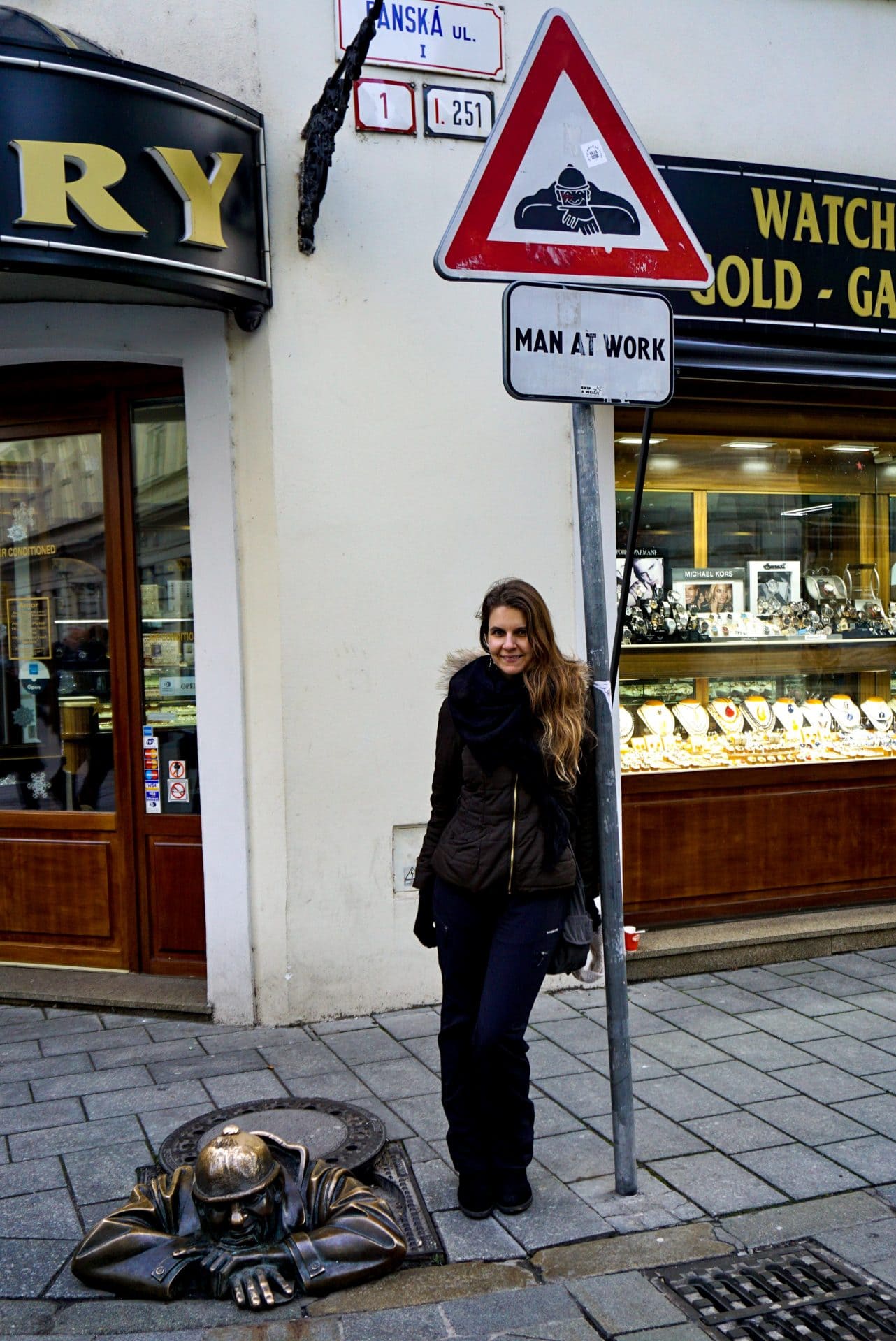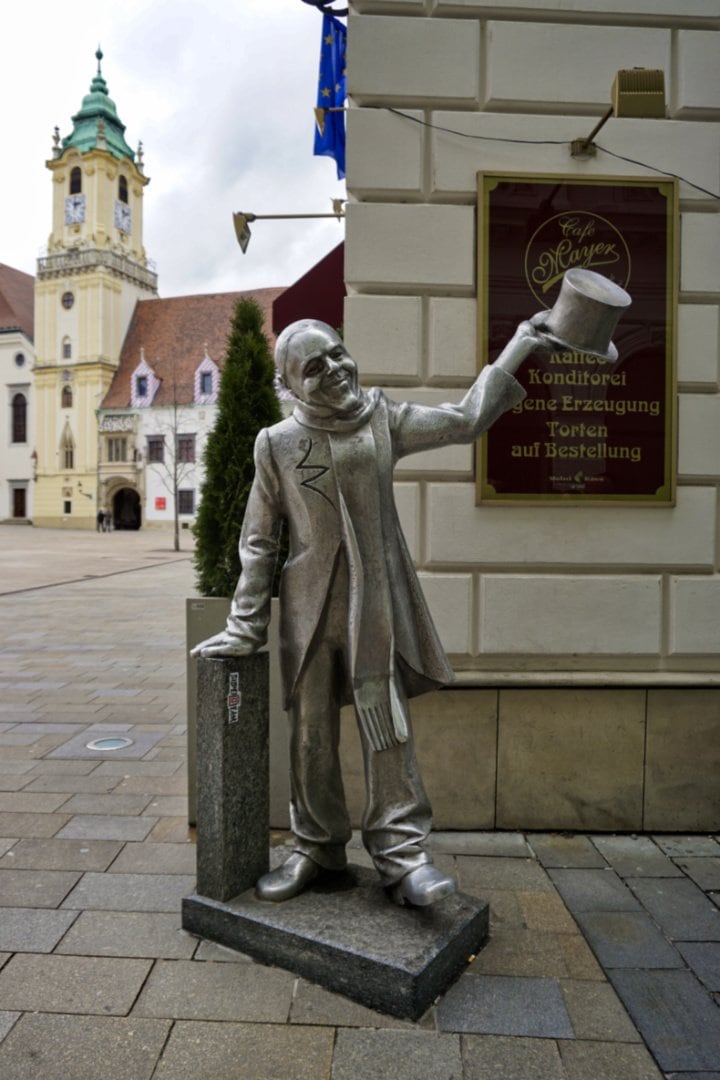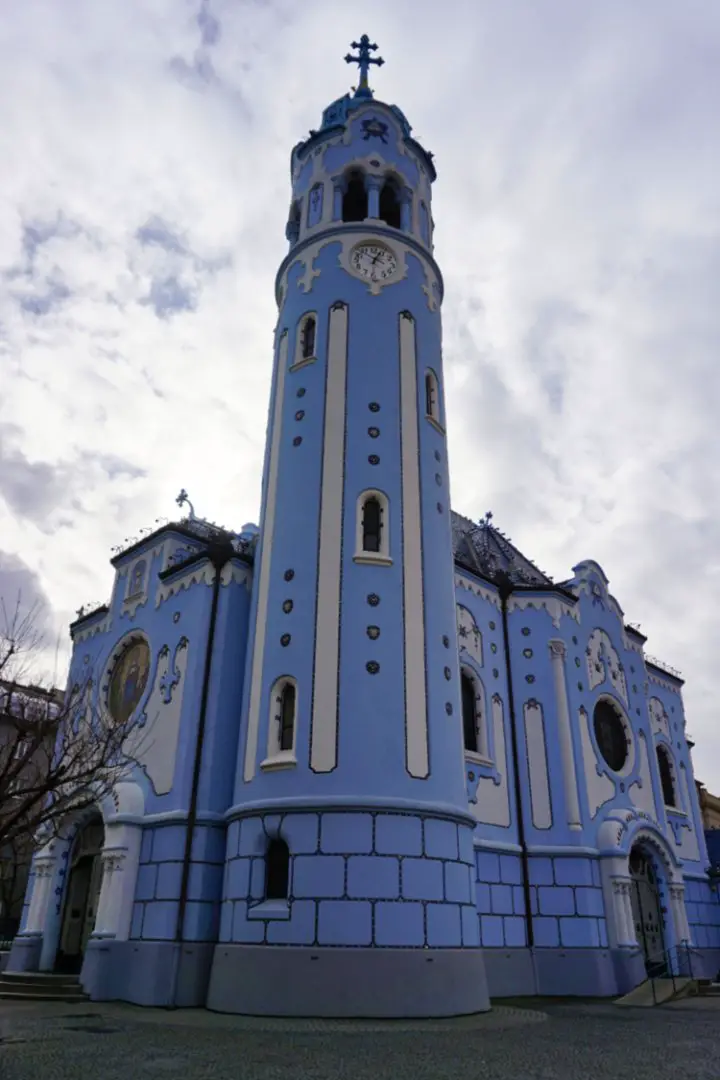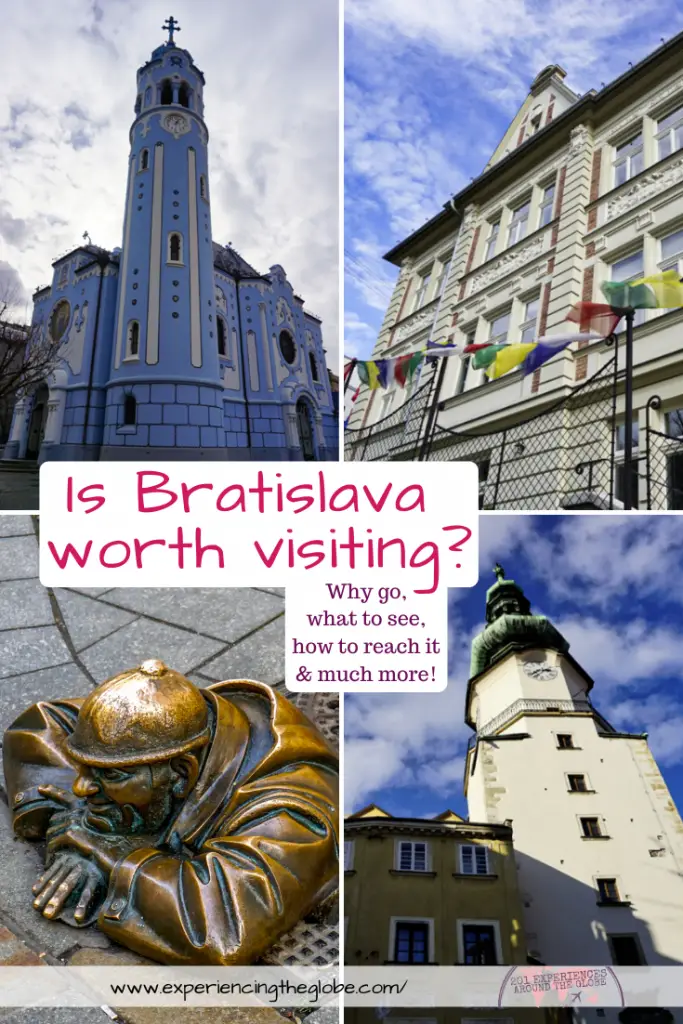

Many times I’ve heard people wondering why visit Bratislava when you can spend more time in Vienna, Budapest or Prague. What they don’t know is that the Slovak capital is the perfect place to see a beautifully conserved medieval city without the crowds of the Western European capitals. It also has stunning architecture –from Art Nouveau to Brutalism– and a series of endearing and quirky sculptures all over town, which give it a special personality. So, is Bratislava worth visiting? I’d say absolutely!
AT A GLANCE
Quick facts about Bratislava → Bratislava is the capital of the Slovak Republic, better known as Slovakia. It borders Austria and Hungary, which makes it the only national capital that borders two countries. These countries have a different name for it: Pozsony in Hungarian and Pressburg in German. It has a population of less than half a million people. It’s part of Schengen area and the Eurozone, which means that if you go overland from any of its neighbors you won’t even need to show your passport (you actually won’t even notice when you cross the border!).
Where to stay in Bratislava? → splurge: Skaritz Hotel & Residence, Grand Hotel River Park, or Roset Boutique Hotel; mid-range: Downtown Bratislava B&B; unique: Botel Gracia; backpackers: Hostel Waltz and Wild Elephants Hostel.
Best time to visit Bratislava → although it’s a year-round destination, the best time to visit is in shoulder season, especially June and September. It has a rather mild climate, with an average temperature of 21 °C (70 °F) in July and −1 °C (30 °F) in January.
Top tours and experiences → a Soviet Era and Post-Communist tour, a night walking tour, a wine tasting experience in the dark, a Carpathian wine tasting tour and a Trenčín, Skalka and Piešťanyand tour.
Must-read books & resources → I can recommend ‘Rivers of Babylon‘ trilogy by Peter Pišťanek; ‘History of the Present‘ by Timothy Garton Ash; and ‘A History of Slovakia: The Struggle for Survival‘ by Stanislav J. Kirschbaum. Also, Lonely Planet is always a good companion –they have a comprehensive guide to Eastern Europe; while Bradt has a but much more detailed guide to Bratislava.
Why do we travel?
‘Travel is only glamorous in retrospect’ read a painted wall of the hostel I stayed during my first visit to Bratislava. I stopped for a minute to fully grasp the concept, because I’ve never thought about it like that, but, hell, how much truth it held (and what a travel lesson it taught me!). After a miserable walk from the bus station in a cold and dark evening in the middle of winter, I was trying to get some feeling back to my frozen toes. I was in fact miserable, but I knew I was going to have fond memories of the trip. Because when you think back, you idealize and completely forget about the crappy times.
Even when you’re cold, scared, sad, or feeling lonely, questioning why you’re not in the comfort of your bed, after having a hot shower and a hearty meal, it dawns on you. It’s because comfort might make your heart warm, but adventure makes it beat. Seeing the world makes you feel alive. Being too comfortable becomes uncomfortable.
Misery was quickly replaced by joy, and my warmed heart helped to warm my feet too. So I headed out to explore. Slovakia was nothing like I expected. I think it’s a completely underrated place. Probably because people visit after Vienna, Prague or Budapest, and Bratislava can’t compete with such grand cities. But what it lacks in splendor it compensates with rawness, in a good way. It’s a smaller place, with beautiful architecture too, and full of little treasures.
After that first trip I was lucky enough to go back during a milder winter, so no misery, only good times. Yay!

Why visit Bratislava?
Art & Architecture
The sculptures
Playful sculptures were what caught my attention first. The city center has several real-life sized statues, waiting to surprise you while passing by. I’ve read about the Man at Work (that’s how it made it to my travel experiences bucket list), so I was on a quest to find him. It wasn’t hard. After being beheaded a couple of times by reckless drivers, the city placed an original sign showing his location.
Čumil, his actual name, has many ‘explanations’. Some say it’s a satire, a way to describe the laziness of Slovaks. Others see him as an anonymous hero, like the many men that helped with the reconstruction of the city. It’s also rumored that this man is just trying to sneak a peek under the ladies’ dresses. Probably they were all present in the mind of the sculpture, Viktor Hulík. What we do know it that a little statue can say a lot about the character of a place.
You can find him at the junction of Laurinská and Panská streets.


Another charming sculpture is Schöne Náci, a mid-20th century character (actually named Ignác Lamár) that was inspired by his grandfather, a famous clown, to bring happiness to people in the streets. Wearing a tailcoat and tipping his hat at the passersby, when a lady headed his way, he’d greet her with an “I kiss your hand”, which he would say in Slovak, German and Hungarian. Another legend states that he lost his mind because his love for a woman was never reciprocated. That’s why he was trying to find a new love on the streets. In any case, now the sculpture is a testament to his whimsical personality.
He is immortalized on Sedlárska street.

A quirky one is The Witch (Bosorka in Slovak). The artist created her as a monument to all the women who were accused of witchcraft in medieval times. Her hair blows wild and a bunch of birds accompany her, while staring.
She lives in the garden below the Bratislava Castle.

As for street art in Bratislava, the trend is just starting to develop. Still, there’s a few cool murals around the city center that are worth looking.
Brutalism
There are several examples of Brutalist architecture in Bratislava, as you’ll find them in every other Eastern European country. Ask the locals and they will point you to the “Kukurica” and the Istropolis in Nové Mesto (the modern part of the city). But you don’t need to go away from the Old Town to find examples.
The most visited one is the UFO bridge (I’ll come back to it and its unique features on the next section, as it’s considered a must see in the city).
My personal favorites are the Slovensky rozhlas, the Slovak Radio and TV building, a reversed pyramid made of steel; and the Druzba, the Union fountain, a concrete pool with an impressive stainless fountain shaped in a very brutal interpretation of a linden flower –which is a symbol of peace, luck and happiness in Slavic mythology.


If you want to see an entire neighborhood built with a Socialist ideology, go across the Danube river into Petržalka. It’s the biggest suburban area in Slovakia, full of paneláky apartment blocks –pre-fab and low-rise concrete apartment blocks. Notoriously, the first post-Communist President of the Czech Republic, Vaclav Havel, called them “undignified rabbit hutches, slated for demolition”.
You would expect them to be grey and dull, but during the 1990’s people started to bring color to the place. And color they brought! Nowadays Petržalka, known as the Bronx of Bratislava, is a vibrant neighborhood, a symbol of the city vivacity and artistic culture.

Art Nouveau
The most prominent example of Art Nouveau in the Slovak capital is the Blue Church (more about it on the must see section). The streets around it are also dotted with buildings in this style. Stroll around Bezručova, Gajova or Jesenského to discover special constructions, including a huge gymnasium.
What I haven’t heard of, and I stumbled upon during my last visit, is that the streets that extend from the Presidential Palace up towards Slavín are too sprinkled with stunning Art Nouveau. Walk through Kuzmányho and Tolstého streets and you’ll see beautiful grand palaces turn into Embassies, hotels and banks. If you pay attention, you’ll even run into a Buddhist temple!

Must see in Bratislava
Bratislava Castle
The castle is the symbol of the city. It sits on top of a rocky hill that’s part of the Little Carpathians, overlooking the Danube river. There’re records of the hill being inhabited from as early as the late Stone Age. From a stone fortress it was turned into a Gothic palace, later rebuilt in Renaissance style, until its last transformation, in the 17th century, when it got the baroque style we see today. It houses now the Slovak National Museum.


Staré Mestro
Bratislava’s Staré Mesto (Old Town) is a beautifully preserved medieval center, rich in history and charm. As you wander its cobbled streets, you’ll find yourself surrounded by centuries-old architecture, lively squares, and some of the city’s most iconic landmarks.
One of the most striking sites is St. Martin’s Cathedral, a magnificent Gothic church dating back to the 15th century. It once served as the coronation site for Hungarian kings and remains one of the city’s most important religious buildings. Not far away stands the Old Town Hall, a blend of architectural styles that has evolved over centuries. Once the seat of city governance, it now houses the Bratislava City Museum.
Another must-see is the Primate’s Palace, an elegant 18th-century Classicist palace that now serves as the seat of Bratislava’s Mayor. Inside, visitors can admire its grand Hall of Mirrors and a collection of rare English tapestries.
For a true sense of the Old Town’s medieval past, walk through St. Michael’s Gate, the last remaining gate of the city’s original 14th-century fortification system. Climb to the top for a fantastic view over the rooftops of Bratislava. Nearby, Laurinská Brána marks the site of another historic city gate, though the original structure was sadly demolished in the 18th century.

Blue church
Even though its color defines it, this quirky Art Nouveau church is named St. Elizabeth, because its consecrated to Elisabeth of Hungary, daughter of Andrew II, who grew up in Bratislava Castle (when it was called Pressburg Castle). It was designed by the architect Ödön Lechner, and built at the beginning of the 20th century, following the Hungarian Secessionist fashion.
Beside its bright blue color, what makes this church unique are the details of its façade, such as mosaics and majolicas. The interior is also a delightful surprise, decorated with light pastel shades of blue.


Presidential palace
Nowadays the seat and residence of the President of the Slovak Republic, this Rococo/late Baroque edifice was built as a summer palace for the Croatian-Hungarian aristocrat Antal Grassalkovich in the 18th century, from whom it got its name: Grassalkovich Palace (Grasalkovičov palác in Slovak).

Slavín
On a hill overlooking Bratislava Castle you’ll find one of the largest war memorials in Europe. The tall monument dominates the city’s skyline. It’s the burial ground of almost seven thousand soldiers of the Soviet army who died during the liberation of Bratislava from German occupying forces in World War II.
On top of an obelisk stands a Soviet soldier hoisting up a flag and crushing a swastika with his foot.
The views of the city from above are absolutely worth the walk uphill, so think active holidays and add it to your itinerary.

UFO bridge and Observation Deck
Most Slovenského národného povstania (Most SNP) means Bridge of the Slovak National Uprising, but due to its flying saucer shape is commonly known as the UFO Bridge (you might hear it also as Nový Most –New Bridge).
A remarkable architectural feature is that the bridge has no pillars in the river, standing in steel ropes only.
The Flying saucer itself houses an observation deck at a height of 95 meters (312 ft) and a restaurant aptly called UFO. Both are accessible using a lift located in the east pillar. The fee for the elevator allows you to go up twice –during day and at night time. The cost is deducted from your bill if you dine at the restaurant, which serves both traditional Slovak and international cuisine.
The observation deck gives you stunning views of the Old Town and the Castle, as well as of Petržalka neighborhood, and the valley of the Danube. It even claims to have a visibility of over 100km (62mi).
If you visit between April and October you can experience the Skywalk: an adrenaline-filled 60-meter (200 ft) stroll around the windowsill of the dome, with 85 meters (280 ft) of free-fall under you.

Pamätaj
On the site of the former Neolog Synagogue (demolished in 1969) there’s a Holocaust Memorial that commemorate the 105,000 victims from Slovakia.
The memorial is a black wall imprinted with the silhouette of the synagogue, and a sculpture that reads “Zachor” (remember in Hebrew] and “Pamätaj” (Remember in Slovak), topped by a Star of David.

Hviezdoslav’s Square
It’s a simple but big pedestrian square, with a statue of the most important poet in the Slovak history, Pavol Országh Hviezdoslav. The most important buildings around it are the Slovak National Theater and the Slovak State Philharmonic.

Practical information
How to get to Bratislava
Flying into Bratislava
Smart Wings, Wizz Air, Corendon Airlines, Tunisair, Ryanair, Pobeda, FlyDubai, Air Cairo, Cyprus Airways and Wizz Air all have direct flights to Bratislava Airport.
From the airport to the city, take bus N°61. In about 25 minutes you’ll be in the main train station, Hlavná Stanica. From there either walk to the city (15-20 minutes) or take bus N°93 or tram N°1.
If you’re flying into Vienna International Airport, you’ll be able to catch a bus to Bratislava directly, without having to go to the Austrian capital first. Several buses going from Vienna to Bratislava stop at the Austrian airport.
How to go from Vienna to Bratislava
The cities are so close by that you could actually walk, if you had a day to spare. There’s only 55km/34mi apart (about 80km/50mi on the road).
The most picturesque way to get to Bratislava is by ferry. The Twin City Liner will take you on a journey of about 1 hour 15 minutes on the Danube. This is the most expensive alternative, and it only runs from April to October.
The eco-friendliest way to go is taking a train. They depart from Wien Hauptbahnhof and arrive to Bratislava Hlavná Stanica, with a journey of a bit over an hour.
The cheapest option is by bus. There are several lines going almost all the time (at least 4-5 departures per hour). The ride will take anywhere between an hour and fifteen minutes to 2 hours, depending on the traffic.
How to go from Budapest to Bratislava
There’s a train from Budapest-Nyugati, but it only goes every 4 hours and you need to change trains in Vác. The whole journey takes 2 and a half hours, and it’s a bit more expensive than the bus. It is the most environmentally friendly choice, though.
Even with that said, the easiest option is to take a bus. Several lines go through this route, like FlixBus, RegioJet, Eurolines and SlovakLines. The journey will take between 2 and a half to 3 hours.
Pro tip: if taking the bus, mind that Budapest has 2 international bus stations. Try to go to Könyves Kálmán körút, because it’s much easier to navigate than Kelenföld. The buses stop at the latter in the streets around the train station, and there’s no one to ask for info about your departure. The former is a normal bus station, with platform numbers.
How to go from Prague to Bratislava
The train from Prague central station (Hlavni Nadrazi) takes approximately 4 hours, and there are 8 to 16 departures daily, depending on the season.
As for buses, they’re slightly cheaper and the journey lasts for an average of 4 and a half hours. There are plenty of connections throughout the day, as many lines have Bratislava as a stop in their route from Prague to Budapest.
Where to stay in Bratislava?
The city is affordable, so you’ll easily find accommodation for any budget you’re in. If you want to splurge, you can’t go wrong with the Skaritz Hotel & Residence, the Grand Hotel River Park, or the Roset Boutique Hotel. For a quirky spin on accommodation try Botel Gracia. A solid mid-range option is Downtown Bratislava B&B. For backpackers, Waltz and Wild Elephants are great hostels.
What else to visit in Slovakia?
If you only have one extra day, I’d recommend that you take a Carpathian wine tasting tour, or one that combines Trenčín, Skalka and Piešťany. Or to stay in the city and try a wine tasting experience in the dark. If you have more time to explore Slovakia, don’t miss the Tatra mountains. If you’re looking for another city break, add Košice to your itinerary.
Liked it? Want to read it later? Pin it!


Enjoyed what you read? A lovely way to show your appreciation is by buying me a cup of coffee 🙂
Your support will ensure I keep bringing you stories and insights from around the world! Thanks so much!


I’ll get there one day, especially having read your article. I love how the city’s history is so clearly on display with its architecture and art work. Thank you for sharing your experiences, it’s definitely inspired me to take a trip to Slovakia.
I’m happy I’m giving you a bit of wanderlust! Whenever you go to Vienna, Budapest or Prague, just add a few days to see a bit of Slovakia. You won’t regret it!
You seem to be a person who does not often choose beaten pathways. It is interesting that you picked Bratislava to visit as opposed to other popular places like Vienna or Prague. Bratislava’s old town of Staré Mestro reminds me of Old San Juan in Puerto Rico to the extent that it seems to hold a lot of interesting history waiting to be explored. I am impressed by the your philosophical statement that “Being too comfortable becomes uncomfortable”.
What a sweet message! Thanks Ingrid! You read me right. I love to go off the beaten path, I enjoy discovering new things more than anything! And that makes me the kind of person that doesn’t enjoy being too comfortable, as weird as that sounds.
I haven’t been to Puerto Rico yet, but old towns all around Caribbean had that unexplored vibe. Most people go straight to the resorts, and miss out on the amazing treasures that are waiting to be discovered.
Looks like an amazing place to visit, I love how you brought me there with you basically. Need to go in person!
Thanks so much for your words, Leigh! I love that you felt that way, because that’s exactly what I want to accomplish with my blog 💕 Please let me know when you go!
Yeah, I wouldn’t go out of my way to look for something but if i find it , I would think of you for sure. Great pictures. Such wonderful memories
Thanks Aditi! I hope find plenty of amazing things in you adventures 🙂
Such a great quote to open with because of how true it is! I’d love to visit Bratislava one day. I’ll be sure to look for that guy, too!
Every trip is special on its own way, and you always learn something. That quote made that trip. It got me to understand that even the bad parts can be enjoyed, even if it’s only in retrospect…
I have always wanted to go since I saw someone on Instagram say it was pretty! Looks fun too.
It’s one of those cities that’s completely off people’s radar, but it’s so worth it! Hope you get to go soon 🙂
I’d love to visit there with my hubby! It would be such a neat experience to do this!
It’s a lovely underrated city. Hope you and your husband make there soon! 🙂
omg I love the last photo, the big tower looks like an alien ship!
Right? And the fog that day created an even more dramatic view 🙂
Wow! It looks so cute and quaint! you describe it so well, and the man at work is pretty cool! Hopefully one day I can travel and witness great places like this one, thank you.
Thank you, Lyn! This is such a sweet comment! Hope you get to go soon <3
Definitely adding Bratislava to my “want to visit”-list after seeing this, love the pictures. Is it a cheap city to be in, you think? 🙂
Thanks so much! I’m so happy to be spreading the wanderlust! 😊
For a European capital city, it’s really cheap. Especially if you’re going from Vienna or Prague, you’ll feel like a millionaire! You can eat for a few euros, and have a nice beer for less than 1€!
Please let me go how the trip goes. Happy travels!
Looks like a great little place and that statue is super cool! Very humorous with the sign as well!
It’s a treasure in Eastern Europe. Always overlooked, but absolutely worth the trip 🙂